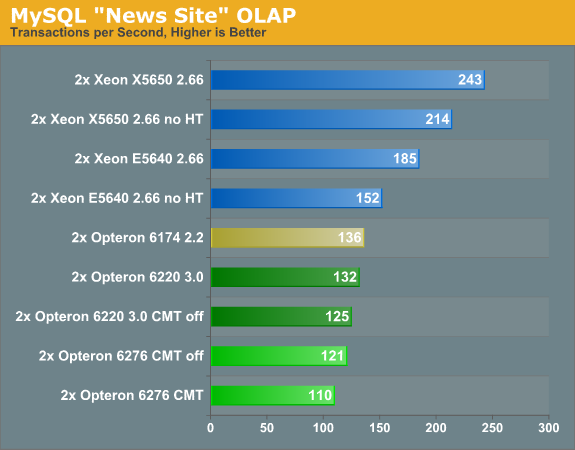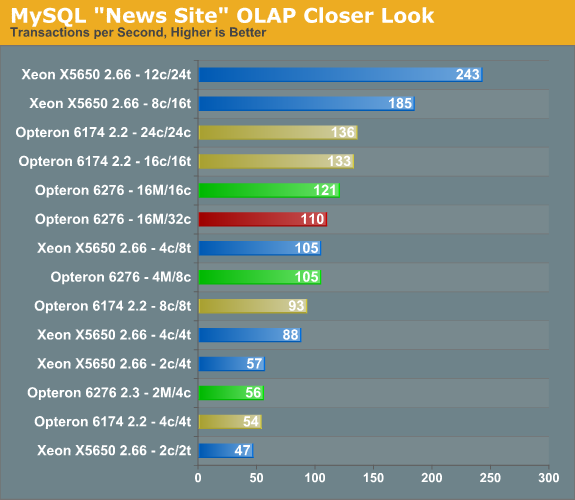The Opteron 6276: a closer look
by Johan De Gelas on February 9, 2012 6:00 AM EST- Posted in
- IT Computing
- CPUs
- Bulldozer
- AMD
- Opteron
- Cloud Computing
- Interlagos
MySQL 5.5.17 "Percona Server"
Many readers asked us why we only tested MySQL in a virtualized environment and not on "native" Linux. Indeed, it has been years since we tested MySQL "natively". The reason is simple: MySQL 5.1 and earlier versions scaled pretty badly beyond 4-8 cores, so there is no incentive to run them on modern dual socket servers. However, starting in December 2010, MySQL 5.5 has been available and it should feature much improved scalability. Even better, the people at Percona released their version of MySQL and the Innodb Storage Engine, Percona Server with XtraDB. This MySQL/Innodb combination is engineered for even better scalability.
To test this, we installed Percona Server 5.5.17-55 (Release 22.1, November 2011) on top of a Ubuntu 11.10 x86-64 linux with the 3.0.0-14 kernel. This kernel was the latest stable version at the time and is "Bulldozer/Interlagos aware".
We migrated the "Nieuws.be" database to MySQL to have a test similar to our SQL server test. That migration is not perfect as not all stored procedures were successfully converted, so you should not use the benchmark results below to compare SQL Server and MySQL. However, the profile of the test is the same: it is 99% complex selects that scan large parts of the database. The database is several tens of gigabytes instead of one.

The results are abysmal for the latest Interlagos Opteron. The best Xeon score is 84% better than the best Opteron score. The results indicate what went wrong: the 8 thread Opteron 6220 at 3GHz scores better than the 16 thread Opteron 6276 at 2.3GHz. A clockspeed advantage of 30% has prevailed over twice as many threads. So we can suspect that the scaling problems are not gone, at least in this test.
Let us take a closer look by performing the same test on a different number of threads and cores. The BIOS of the SuperMicro H8DGU-F allowed us to disable the second integer unit or one or more modules of the new Opterons. (Disabling both at the same time was not possible.) The Asus Z8PS-D12-1U was more flexible: we could disable Hyper-Threading and/or several cores of the Xeon. Here are the scaling results.

First, we focus on the results with few cores and threads. Two Bulldozer Modules are capable of slightly outperforming four cores of the Opteron Magny-Cours. The ideas behind Bulldozer are sound: two modules are smaller (157 mm²) and more power efficient than four K10 cores (231 mm²). At the same time they perform equal to the Xeon X5650—which is clocked higher—with the same amount of threads. At eight threads this is still the case, and the gap between the newer and older Opteron widens in favor of the former.
Beyond eight threads, the new Opteron starts to scale badly. Doubling the number of modules to eight delivers a very small 5% performance advantage. Double the number of modules again and you end up with negative scaling. To make matters worse, the Xeon doesn't have this problem. From eight to 16 threads we get a 76% performance boost. The end result is that a quad-core Xeon beats the best Opteron by a large margin. Let us investigate the matter further.










46 Comments
View All Comments
Jaguar36 - Thursday, February 9, 2012 - link
I too would love to see more HPC related benchmarks. Finite Element Analysis (FEA) or Computational Fluid Dynamic (CFD) programs scale very well with increased core count, and are something that is highly CPU dependent. I've found it very difficult to find good performance information for CPUs under this load.I'd be happy to help out developing some benchmark problems if need be.
dcollins - Thursday, February 9, 2012 - link
These would indeed be interesting benchmarks to see. These workloads are very floating point heavy so I imagine that the new Opterons will perform poorly. 16 modules won't matter when they only have 8 FPUs. Of course, I am speculating here.Going forward, these types of workloads should be moving toward GPUs rather than CPUs, but I understand the burden of legacy software.
silverblue - Friday, February 10, 2012 - link
They have 8 FPUs capable of 16x 128-bit or 8x 256-bit instructions per clock. On that level, it shouldn't be at a disadvantage.bnolsen - Sunday, February 12, 2012 - link
GPUs are pretty poor for general purpose HPC. If someone wants to fork out tons of $$$ to hack their problem onto a gpu (or they get lucky and somehow their problem fits a gpu well) that's fine but not really smart considering how short release cycles are, etc.I have access to a quad socket magny cours built mid last year. In december I put together a sandy-e 3930k portable demo system. Needless to say the 3930k had at least 10% more throughput on heavy processing tasks (enabling all intel sse dropped in another 15%). It also handily beat our dual xeon nehalem development system as well. With mixed IO and cpu heavy loads the advantage dropped but was still there.
I'd love to be able to test these new amds just to see but its been much easier telling customers to stick with intel, especially with this new amd cpu.
MySchizoBuddy - Friday, March 9, 2012 - link
"GPUs are pretty poor for general purpose HPC."tell that to the #2, #4 and #5 most powerful supercomputers in the world. I'm sure no one told them.
hooflung - Thursday, February 9, 2012 - link
I think I'd rather see some benchmarks based around Java EE6 and an appropriate container such as Jboss AS 7. I'd also like to see some Java 7 application benchmarks ( server oriented ).I'd also like to see some custom Java benchmarks using Akka library so we can see some Software transactional memory benchmarks. Possibly a node.js benchmark as well to see if these new technologies can scale.
What I've seen here is that the enterprise circa 2006 has a love hate relationship with AMD. I'd also like to see some benchmarks of the Intel vs AMD vs SPARC T4 in both virtualized and non virtualized J2EE environments. But this article does have some really interesting data.
jibberegg - Thursday, February 9, 2012 - link
Thanks for the great and informative article! Minor typo for you..."Using a PDU for accurate power measurements might same pretty insane"
should be
"Using a PDU for accurate power measurements might seem pretty insane"
phoenix_rizzen - Thursday, February 9, 2012 - link
MySQL has to be the absolute worst possible choice for testing multi-core CPUs (as evidenced in this review). It just doesn't scale beyond 4-8 cores, depending on CPU choice and MySQL version.A much better choice for "alternative SQL database" would be PostgreSQL. That at least scales to 32 cores (possibly more, but I've never seen a benchmark beyond 32). Not to mention it's a much better RDBMS than MySQL.
MySQL really is only a toy. The fact that many large websites run on top of MySQL doesn't change that fact.
PixyMisa - Friday, February 10, 2012 - link
This is a very good point. While it can be done, it's very fiddly to get MySQL to scale to many CPUs, much simpler to just shard the database and run multiple instances of MySQL. (And replication is single-threaded anyway, so if you manage to get one MySQL instance running with very high inserts/updates, you'll find replication can't keep up.)Same goes for MongoDB and, of course, Redis, which is single-threaded.
We have ten large Opteron servers running CentOS 6, five 32-core and five 48-core, and all our applications are sharded and virtualised at a point where the individual nodes still have room to scale. Since our applications are too large to run un-sharded anyway, and the e7 Xeons cost an absolute fortune, the Opteron was the way to go.
The only back-end software we've found that scales smoothly to large numbers of CPUs is written in Erlang - RabbitMQ, CouchDB, and Riak. We love RabbitMQ and use it everywhere; unfortunately, while CouchDB and Riak scale very nicely, they start out pretty darn slow.
We actually ran a couple of 40-core e7 Xeon systems for a few months, and they had some pretty serious performance problems for certain workloads too - where the same workload worked fine on either a dual X5670 or a quad Opteron. Working out why things don't scale is often more work than just fixing them so that they do; sometimes the only practical thing to do is know what platform works for what workload, and use the right hardware for the task at hand.
Having said all that, the MySQL results are still disappointing.
JohanAnandtech - Friday, February 10, 2012 - link
"It just doesn't scale beyond 4-8 cores, depending on CPU choice and MySQL version."You missed something: it does scale beyond 12 Xeon cores, and I estimate that scaling won't be bad until you go beyond 24 cores. I don't see why the current implementation of MySQL should be called a toy.
PostgreSQL: interesting several readers have told me this too. I hope it is true, because last time we test PostgreSQL was worse than the current MySQL.